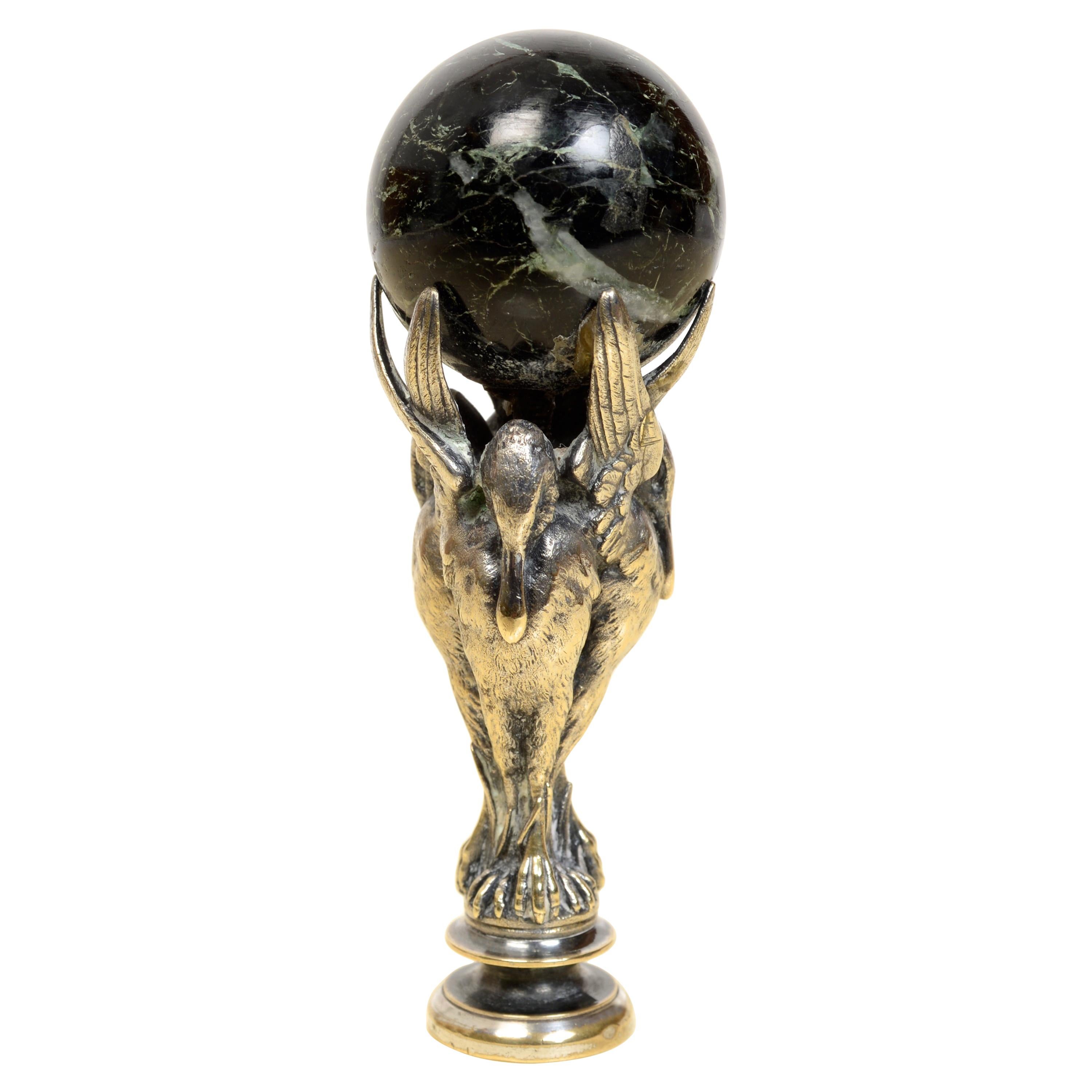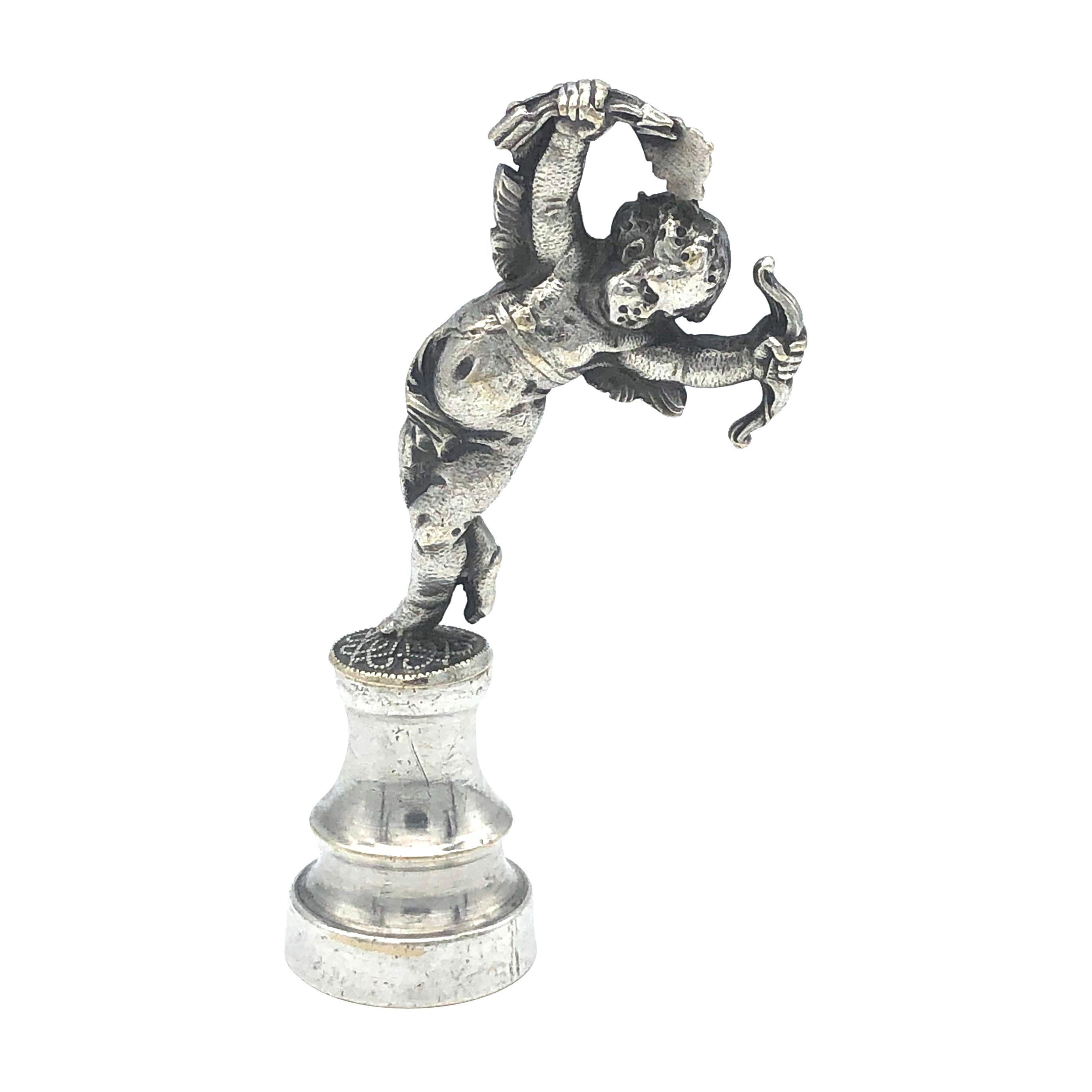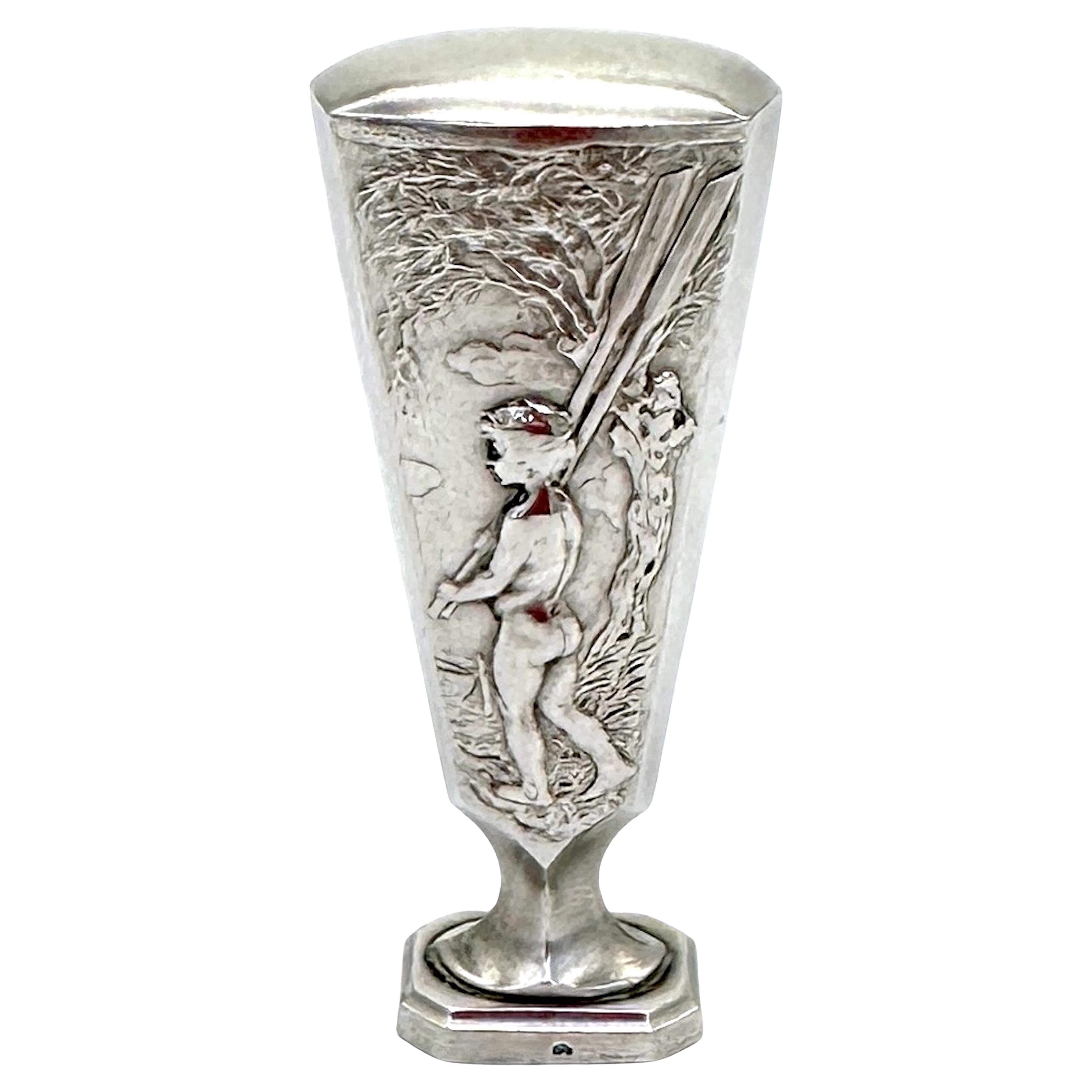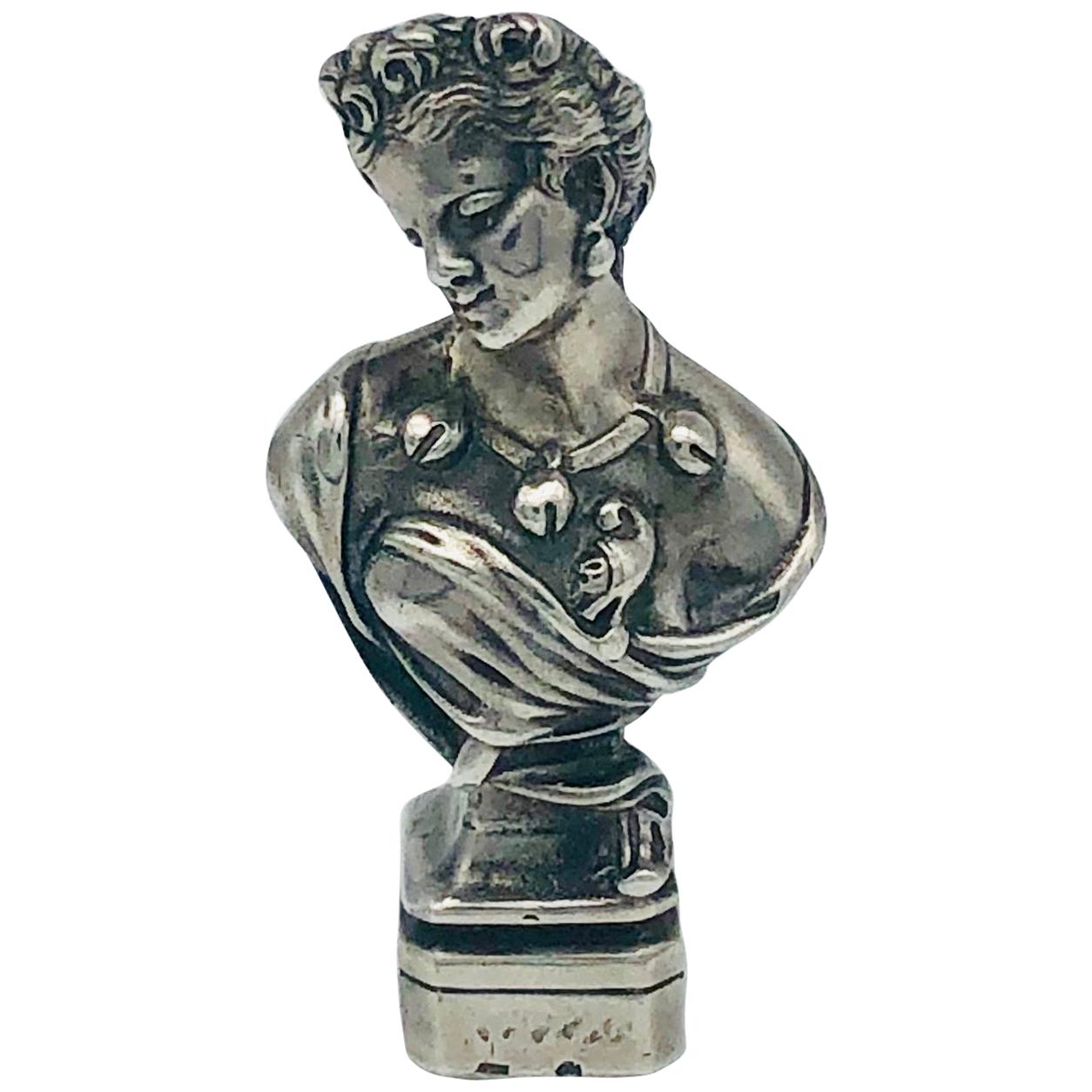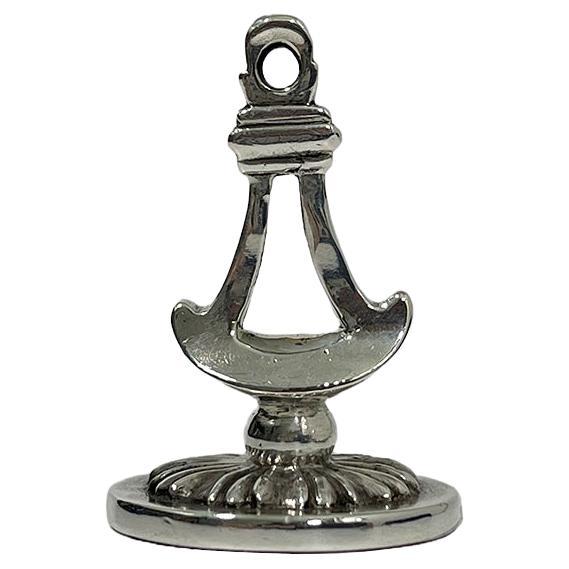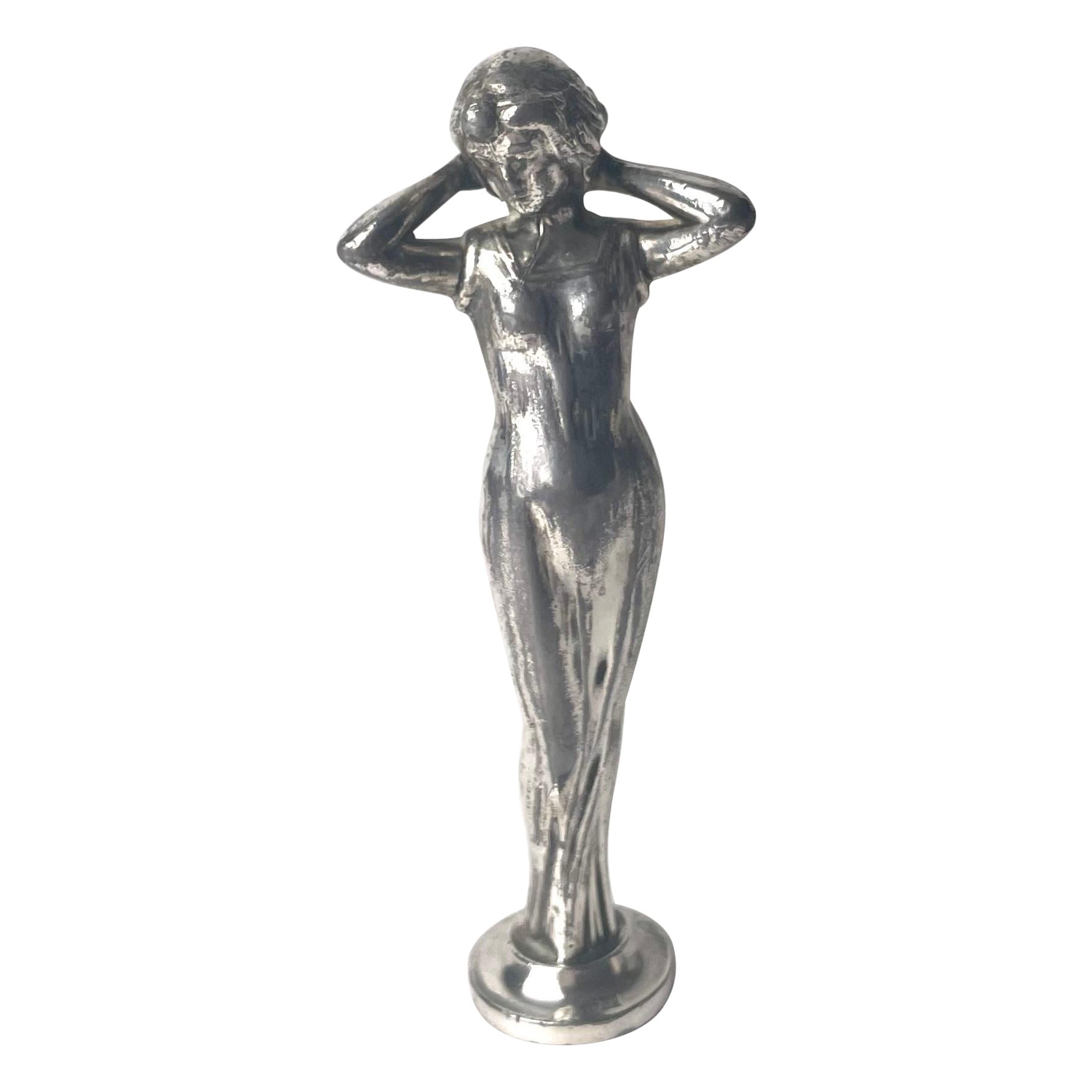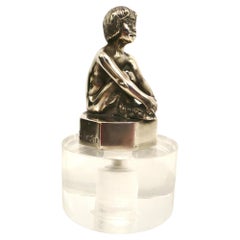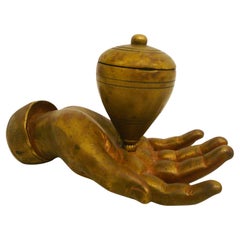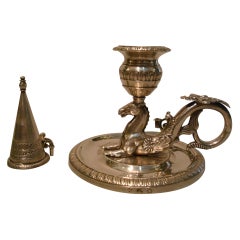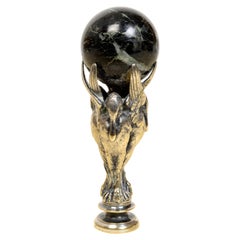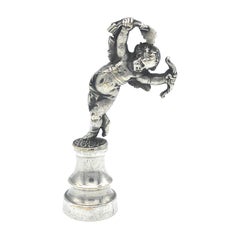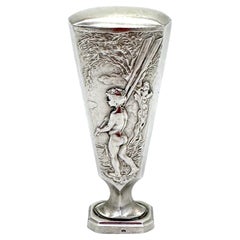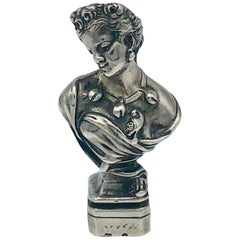Items Similar to Antique God Atlas Sterling Silver Figural Wax Seal Stamper. German 19-Century.
Want more images or videos?
Request additional images or videos from the seller
1 of 12
Antique God Atlas Sterling Silver Figural Wax Seal Stamper. German 19-Century.
$2,500
£1,892.74
€2,192.01
CA$3,538.07
A$3,964.07
CHF 2,061.49
MX$48,027.68
NOK 26,264.28
SEK 24,518.62
DKK 16,362.92
About the Item
Antique God Atlas Sterling Silver Figural Wax Seal Stamper.
Rara Antique, circa 1850, wax seal stamp.
Moldelled as the God Atlas (Greek Mythology).
The globe rotates.
Museum quality.
In Greek mythology, Atlas is a Titan condemned to hold up the heavens or sky for eternity after the Titanomachy. Atlas also plays a role in the myths of two of the greatest Greek heroes: Heracles (Hercules in Roman mythology) and Perseus. According to the ancient Greek poet Hesiod, Atlas stood at the ends of the earth in the extreme west. Later, he became commonly identified with the Atlas Mountains in northwest Africa and was said to be the first King of Mauretania (modern-day Morocco and west Algeria, not to be confused with the modern-day country of Mauritania). Atlas was said to have been skilled in philosophy, mathematics, and astronomy. In antiquity, he was credited with inventing the first celestial sphere. In some texts, he is even credited with the invention of astronomy itself.
We have specialized in the sale of Art Deco and Art Nouveau and Vintage styles since 1995. If you have any questions we are at your disposal. Pushing the button that reads 'View All From Seller'. And you can see more objects to the style for sale. Why are there so many antiques in Argentina?
In the 1880 – 1940 there was a grate wave of immigration encouraged by the periods of war that were taking place. 1st World War took place between 1914 and 1918 2nd World War took place between 1939 and 1945 The immigrants options were New York or Buenos Aires. Tickets were cheap and in Buenos Aires they were welcomed with open arms, as it was a country where everything was still to be done. Argentina was the country of new opportunities, labour was needed and religious freedom was assured, in many cases the of the family travel first until they were settled and then the rest of the family members join them. In the immigrant museum “Ellis Island Immigrant Building” in New York you can se the promotional posters of the boats that would take them to a new life. Between the years 1895 and 1896, Argentina had the highest DGP (gross domestic product) per capita in the world according to the Maddison Historical Statistics index, this situation arose due to the large amount of food being exported to European countries, which were at war. The Argentinean ships left the port of Buenos Aires with food, but they returned with furniture, clothes and construction elements, (it´s common to see this the old buildings of the historic neighbourhood of San Telmo, the beams with the inscription “Made in England)”, as well as many markets that were built in Buenos Aires, such us the San Telmo Market, whose structure was brought by ship and afterwards assembled in 900 Defensa Street. With the great influence of European immigrants living in the country, the children of the upper classes travelled to study in France, resulting in the inauguration of “La Maison Argentinienne”, on 27th of June 1928, in the international city of Paris, which hosted many Argentinians that were studying in Frace. It´s the fourth house to be built after France, Canada and Belgium, being the first Spanish-speaking one. Still in place today (17 Bd Jourdan, 75014, Paris, France). Many of the children of these wealthy families who attended international art exhibitions, museums and art courses abroad, took a keen interest in the European style. This is why Buenos Aires was at the time referred as “The Paris of South America”. Between the years 1890 and 1920 more than a hundred Palaces were built on Alvear Avenue the most exclusive avenue in Buenos Aires. Today some of these palaces have been transformed into museums, hotels and embassies. In the year 1936, the Kavanagh building was inaugurated, it was the tallest reinforced concrete building in South America. During 1994 the American Society of Civil Engineers distinguished it as an “international engineering milestone”, and it´s now considered a World Heritage of Modern Architecture. At the time was common to hire foreign architects such as Le Corbusier, who visited Buenos Aires/Argentina in 1929 and in 1948 he drew up the blueprints for a house built in La Plata City (which was declared a World Heritage Site). In 1947, the Hungarian architect Marcelo Breuer designed “Parador Ariston” in the seaside city of Mar del Plata. After an Argentinean student at Harvard University convinced him to come to Argentina. He worked on an urban development project in the Casa Amarilla, area of La Boca. The Ukrainian architect, Vladimiro Acosta, arrives in Argentina in 1928 and worked as an architect until que moved to Brazil. Antonio Bonet, a Spanish architect who worked with Le Corbusier in Paris, arrives in Argentina in 1937, where he carried out several architectural works and in 1938 designs the well-known BFK chair. Andres Kálnay, of Hungarian origin, made around 120 architectural masterpieces, among which the former Munich brewery stands out, he even made the furniture’s design. The German architect, Walter Gropius, director of the Bauhaus, lived in Argentina, where he wrote articles for “Sur” magazine and founded in Buenos Aires, an architectural firm with Franz Möller, who was also an architect, where he built two houses. At the same time several famous designers decided to immigrate to Argentina, among them we can find the well-known French designer, Jean-Michel Frank, who arrived in the country in 1940 and also worked for the Rockefeller family. Special pieces were made, which were sold exclusively in the country, such as the well-known German company “WMF”, who sold their products by catalogue, which were chosen by the ladies of high society in the list of wedding gifts, as well as the pieces designed by Christofle. The Swiss sculptor Alberto Giacometti, made special pieces for Argentinean mansions. In 1904 the first Jansen branch outside Paris was established in Buenos Aires, as the Argentinean clientele demanded a large amount of furniture, from the end of the 19th century to the mid-20th century. In 1970, the brand Rigolleau Argentina made pieces authorised by Lalique. The brands Maple and Thompson also set up shop in the country. The French plastic artist, Marcel Duchamp moved to Argentina in 1918-1919. Glass signed Gallé, Charder, Leverre, Schneider, Muller and other French firms. They were bought in flower shops and were given to ladies with beautiful floral arrangements. Some furniture manufacturers travelled to international fairs and bough the patterns to produce the furniture in Argentina, such as the furniture firm Englander and Bonta, who bought the patterns in Italy. It is worth mentioning that in Argentina we have the largest community of Italians outside of Italy, as it is estimated that 70 percent of the inhabitants have at least one Italian descendant, followed by Spanish immigrants. The most Important furniture stores in Argentina: Comte is founded in 1934 (under the direct management of Jean Michel Frank in 1940). Nordiska (Swedish company established in 1934). Churba in 1960, a company that brought foreign designers to present their furniture in the country: Denmark: (Arne Jacobsen, Finn Juhl, Bender Madsen, Ejner Larsen, Poul Kjaerholm, Hans Wegner) Sweden: (Hans Agne Jakobsson, Gustavsberg) United States: (Herman Miller) Finland: (Lisa Johansson, Folke Arstrom, Tapio Wirkkala, Alvar Aalto, Timo Sarpaneva) Swedish Factory: (Orrefors) Italy: (Littala, Vico Magistretti, Emma Gismondi, Gae Aulenti, Angelo Mangiarotti, Elio Martinelli, Gianna Celada, Angelo Mangiarotti, Mario Bellini, Carlo Scarpa) Finland: (Olivia Toikka) Plata Lappas (Lappas Silver): a goldsmith shop founded in 1887 in Argentina by Alcibiades Lappas of Greek origin. In 2019, in Argentina took place “the Art Deco world congress” . Argentina currently has more than 100 Art Deco buildings and another 90 Art Nouveau buildings throughout the city of Buenos Aires. Argentina is a country that has not been involved in many wars, which is why it has been a refuge for works of art and antiques from different periods of time, unlike European countries. That is way many collectors, museums and antique dealers from all over the world visit it, you should not miss the opportunity to visit this great country.
- Dimensions:Height: 2.96 in (7.5 cm)Diameter: 1.11 in (2.8 cm)
- Style:Classical Greek (In the Style Of)
- Materials and Techniques:
- Place of Origin:
- Period:
- Date of Manufacture:1850
- Condition:Wear consistent with age and use.
- Seller Location:Buenos Aires, AR
- Reference Number:1stDibs: LU2027346255772
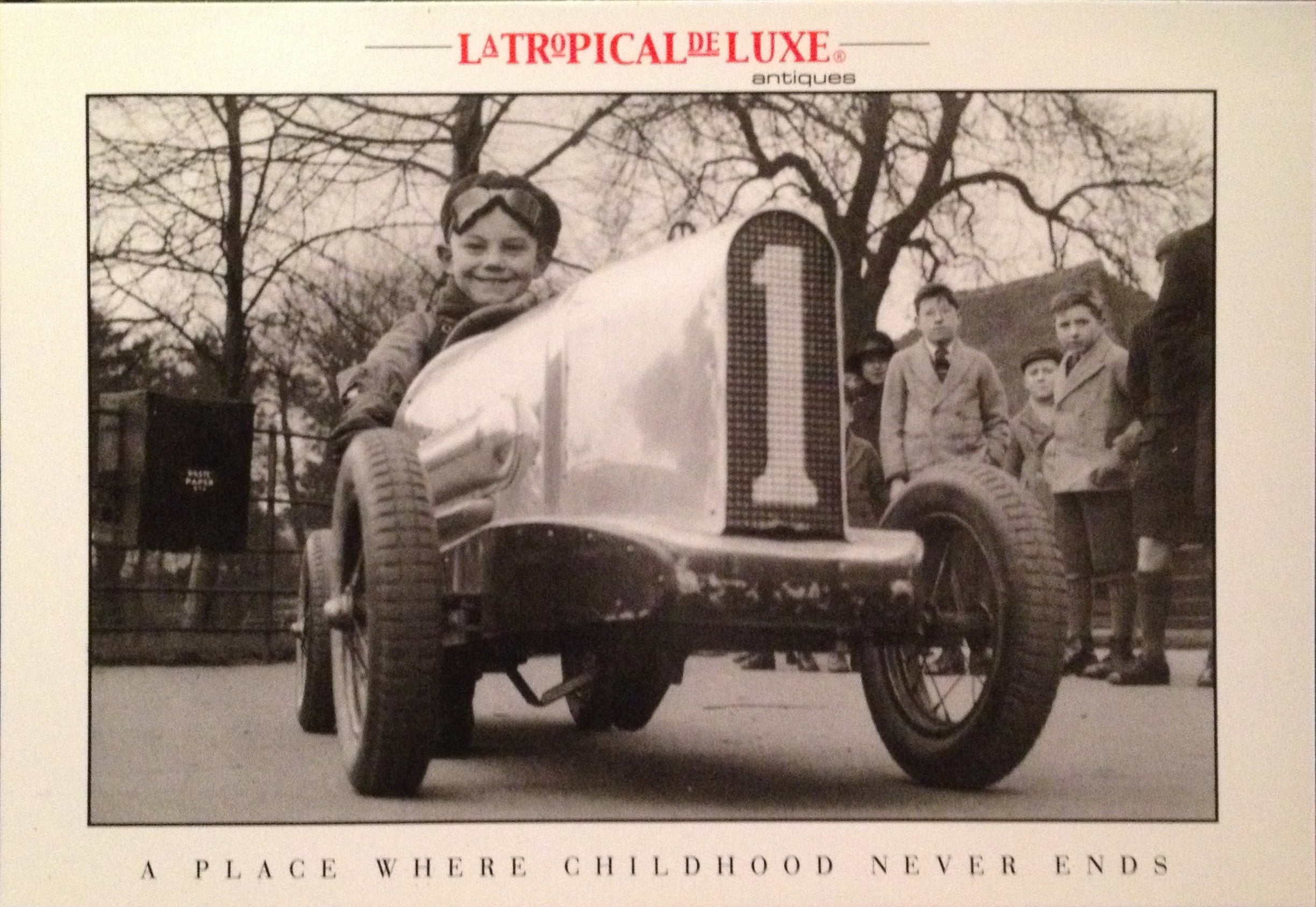
About the Seller
4.9
Vetted Professional Seller
Every seller passes strict standards for authenticity and reliability
Established in 2002
1stDibs seller since 2016
322 sales on 1stDibs
Typical response time: 1 hour
- ShippingRetrieving quote...Shipping from: Buenos Aires, Argentina
- Return Policy
Authenticity Guarantee
In the unlikely event there’s an issue with an item’s authenticity, contact us within 1 year for a full refund. DetailsMoney-Back Guarantee
If your item is not as described, is damaged in transit, or does not arrive, contact us within 7 days for a full refund. Details24-Hour Cancellation
You have a 24-hour grace period in which to reconsider your purchase, with no questions asked.Vetted Professional Sellers
Our world-class sellers must adhere to strict standards for service and quality, maintaining the integrity of our listings.Price-Match Guarantee
If you find that a seller listed the same item for a lower price elsewhere, we’ll match it.Trusted Global Delivery
Our best-in-class carrier network provides specialized shipping options worldwide, including custom delivery.More From This Seller
View AllThomas Messenger and Sons 'Atlas' Sculpture Bronze Lamp Base, England circa 1835
By Thomas Messenger
Located in Buenos Aires, Olivos
Thomas Messenger and Sons 'Atlas' Sculpture Silvered Bronze Lamp Base, England circa 1835.
English William IV period, bronze table lamp by the Birmin...
Category
Antique 19th Century English Regency Figurative Sculptures
Materials
Bronze
Art Deco Silvered Bronze Faun, Car Mascot Hood Ornament, France, 1920
By Paul Silvestre, Susse Freres
Located in Buenos Aires, Olivos
Rare Art Deco silvered bronze statuette of a seated young boy Faun. Car mascot hood ornament. Figure mounted over a base. Perfect desk piece.
Signed 'Silvestre' with foundry marks f...
Category
Early 20th Century French Art Deco Figurative Sculptures
Materials
Bronze
Bronze Hand Inkstand / Inkwell Desk Piece
Located in Buenos Aires, Olivos
A bronze sculpture of a hand with an open palm. Resting on the palm is a bronze object that resembles a traditional spinning top. The hand appears to be life-sized (Small Children s...
Category
Antique Late 19th Century English Victorian Inkwells
Materials
Bronze
Silver Chamberstick / Candleholder Hippocampus / Seahorse, 1837 Munich, Germany
Located in Buenos Aires, Olivos
Silver Chamberstick / candleholder hippocampus / seahorse, circa 1837 Munich, Germany.
This silver Chamberstick retain the original detachable snuffer.
We have specialized in the sa...
Category
Antique 1830s German Early Victorian Natural Specimens
Materials
Silver, Sterling Silver
Art Deco / Mid-century Silvered Bronze Bust Sculpture - France 1930´s
Located in Buenos Aires, Olivos
Art Deco / Midcentury Silvered Bronze Bust - France 1930´s.
Silvered Bronze Head mounted over Onyx Marble.
Very nice Sculpture, perfect for a desk or a side table.
We have speciali...
Category
Mid-20th Century French Art Deco Busts
Materials
Onyx, Bronze
Art Nouveau sculpture desk Inkwell Stand, Figure of the Law and Justice 1900´s
By WMF Württembergische Metallwarenfabrik
Located in Buenos Aires, Olivos
WMF, superb Art Nouveau desk inkwell. Wonderful work. Maker mark for WMF. Model 288. The Lady is the Law. Similar to the justice sculpture See Photos...
Category
Early 20th Century German Art Nouveau Figurative Sculptures
Materials
Spelter
$1,440 Sale Price
42% Off
Free Shipping
You May Also Like
Silver Plated Desk Seal, Late 19th/20th C with Heron Supported Marble Sphere
Located in valatie, NY
Silver plated desk seal, late 19th early 20th c, with three herons supporting a variegated "Spider Green" marble sphere. The bottom has an engraved seal with the initials "SBM." The ...
Category
Early 20th Century More Desk Accessories
Materials
Marble, Silver Plate
Antique Cupid Amor Dancer Lovetoken Bow Arrow Desktop Seal Silverplate
Located in Munich, Bavaria
Delightfully modelled cupid holding bow and arrows in his hands. The dancing amor is standing on a pedestal. The seal is made out of silver plated metal and carries the initials J D....
Category
Antique 1890s Belle Époque Desk Accessories
Continental Silver Wax Seal with Art Nouveau Figure and Landscape, Circa 1900
Located in West Palm Beach, FL
Continental Silver Wax Seal with Art Nouveau Figure and Landscape, Circa 1900 Stamped . 800 silver with engraved seal "W.G."
Dimensions: 2.5" H x 1" W x 0.5" D
A finely executed Con...
Category
Early 20th Century German Art Nouveau Sterling Silver
Materials
Sterling Silver
Antique Belle Epoque Silver Signet Desk Seal Beauty
Located in Munich, Bavaria
This unusual desktop seal in the shape of a beautiful yong lady wearing roses in her swept up coiffure. She is dressed in a low cut dress and wears an important necklace.
Category
Antique 1880s Belle Époque Desk Accessories
A 19th Century Dutch silver seal wax stamp
Located in Delft, NL
A 19th Century Dutch silver seal wax stamp
A Dutch silver seal wax stamp from the 19th century. A seal stamp showing the Coat of Arms with a crowned shield divided into three sections. The stamp dates before 1893. The stamp is hallmarked with the dolphin in triangle, used between 1893-1906 for non-guaranteed native objects (gilde hallmark). Afterwards marked again later in the 20th century with ZII for the silver purity 833/1000.
Signets or called cachets, wax seal stamps, are stamps that were worn on a silver watch chain...
Category
Antique 19th Century Dutch More Desk Accessories
Materials
Silver
Swedish silver-plated Seal Stamp in Art Nouveau
Located in Knivsta, SE
Swedish silver-plated Seal Stamp in Art Nouveau. Made by GAB, Guldsmedsaktiebolaget, Sweden during the early 20th Century. The stamp with the initials T.R.
The silver plating with p...
Category
Early 20th Century Swedish Art Nouveau Desk Sets
Materials
Metal
